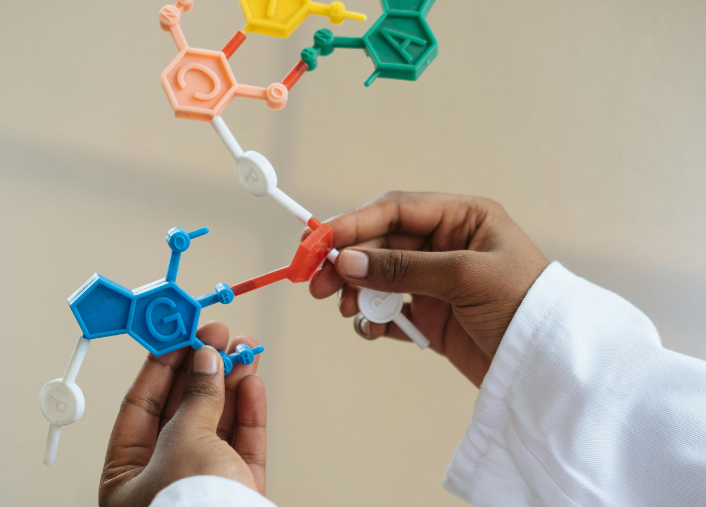Demystifying the Genetics of Sensitivity to Stimuli
Aira
on
August 16, 2024
Have you ever felt overwhelmed by the hum of fluorescent lights, the constant chatter in a crowded room, or the scratchy texture of a certain fabric? If so, you might be more sensitive to stimuli than others. This sensitivity can encompass various experiences, from physical sensations to emotional and social cues.
Understanding sensitivity to stimuli is crucial for navigating the world and creating a comfortable and enriching life.
What is Sensitivity to Stimuli?
Sensitivity to stimuli refers to a heightened awareness and responsiveness to internal and external cues. This can manifest in various ways, including:
- Sensory processing sensitivity (SPS): This is a personality trait characterized by deeper processing of sensory information, leading to a greater susceptibility to overstimulation from sights, sounds, smells, tastes, and textures.
- Highly sensitive person (HSP): This term is used for individuals with SPS. Besides being sensitive to sensory input, they may also feel emotions more intensely and be more empathetic towards others.
- Sensory overload occurs when individuals are bombarded with excessive stimuli, exceeding their ability to process and cope effectively. It can lead to feelings of anxiety, fatigue, and difficulty concentrating.
It’s important to remember that sensitivity to stimuli exists on a spectrum. Everyone experiences the world differently, and there’s no single “normal” level of sensitivity. While some individuals may find certain environments or situations highly stimulating, others might barely register them.

Benefits and Challenges of Sensitivity to Stimuli
People with heightened sensitivity often possess unique strengths. They may have:
- A keen eye for detail: This can be valuable in creative fields, research, and professions requiring meticulous attention.
- Deep empathy and emotional intelligence: This allows them to connect with others on a profound level and provide strong emotional support.
- Rich inner lives: They may experience the world with greater depth and nuance, leading to a deeper appreciation for beauty and creativity.
However, sensitivity can also present challenges:
- Overstimulation: Crowded environments, loud noises, and strong smells can be overwhelming and lead to anxiety, fatigue, and difficulty focusing.
- Sensory aversions: Certain textures, sounds, or smells may trigger negative reactions, making everyday activities challenging.
- Emotional sensitivity: They may be more susceptible to feeling hurt, overwhelmed, or stressed by external stimuli and social interactions.
How Genetics May Influence Sensitivity to Stimuli
Specific genes influence sensitivity to stimuli in our genetic makeup. Here are some genes and their variants that may impact this trait.
NLN and DBH Genes
The rs16894446 in gene NLN has emerged as a significant SNP in influencing sensitivity to stimuli. Major allele homozygotes for rs16894446 reported higher sensitivity on the Highly Sensitive Personality (HSP) scale. This implies that individuals with a specific genetic makeup at this locus are more prone to heightened sensory awareness.
In the case of rs895379 in NLN, major allele homozygotes were associated with lower sensitivity on the HSP scale. This illustrates the diversity of genetic influences, as certain alleles can contribute to a lesser degree of sensitivity in individuals compared to others.
For another SNP in NLN, rs2561196, the minor allele homozygotes reported less sensitivity on the HSP scale.
Similarly, rs1611123 in gene DBH (dopamine beta-hydroxylase) exhibited a notable effect on sensitivity. Major allele homozygotes for rs1611123 reported higher sensitivity on the HSP scale. This suggests a link between the genetic variations at this locus and an individual’s responsiveness to stimuli, contributing to their overall sensory experience.
TH and INS genes
For the TH gene SNP rs4929966, being heterozygotes was associated with higher sensitivity on the HSP scale. This gene variant highlights the role of genetic diversity in influencing sensitivity, with heterozygous individuals experiencing a different level of sensory responsiveness compared to major allele homozygotes or minor allele homozygotes.
The rs3842748 situated between genes TH and INS, displayed a similar connection between genetic makeup and sensitivity. Heterozygotes for rs3842748 reported higher sensitivity on the HSP scale. This reinforces the idea that specific genetic variations contribute to an individual’s predisposition to heightened sensory experiences.
NTRS1 and NTSR2 genes
Contrasting with the previous genes, major allele homozygotes for rs7131056 in gene NTRS1 reported higher sensitivity on the HSP scale. This variation highlights the intricate interplay of different genetic factors, with specific alleles contributing to diverse sensitivities in individuals.
However, for heterozygotes of rs6062460 in NTSR1, a lower sensitivity on the HSP scale was reported. This gene variant adds another layer of complexity to the genetic basis of sensitivity, indicating that the combination of alleles at this locus plays a role in modulating an individual’s sensory experiences.
Additionally, for rs12612207 in the NTSR2 gene, the minor allele homozygotes reported less sensitivity on the HSP scale.
SLC6A3 gene
For the variant rs2975292, the minor allele homozygotes reported less sensitivity on the HSP scale. This highlights the significance of specific genetic variations in influencing sensitivity, with individuals carrying minor alleles exhibiting a different sensory response than major allele homozygotes or heterozygotes.
In summary, these genetic findings underscore the intricate relationship between specific gene, variants, different alleles, and their combinations, and sensitivity to stimuli, emphasizing the polygenic nature of this trait. Each gene contributes uniquely to an individual’s sensory experiences, and their combined effects shape the overall sensitivity observed on the HSP scale.
Non-Genetic Factors Influencing Sensitivity to Stimuli
Sensitivity to stimuli is a complex phenomenon influenced by a variety of factors beyond just our genes. Various elements from our environment and early experiences to our psychological makeup and mental health can shape how we perceive and respond to the world around us.
Neurological differences
Research suggests potential differences in brain structure and function between individuals with high and low SPS. A 2021 study found evidence of altered brain activity in the amygdala and insula in HSPs compared to controls, suggesting these regions might play a role in heightened emotional processing.
Early childhood experiences
Early life experiences, such as neglect or abuse, can impact sensory processing. A 2018 study found a correlation between adverse childhood experiences (ACEs) and higher self-reported SPS.
Stress
Chronic stress can exacerbate sensitivity to stimuli. A 2022 study found that stress exposure can increase noise sensitivity in healthy individuals.
Personality traits
Certain personality traits, such as neuroticism and introversion, may be linked to increased sensitivity to stimuli. A 2023 study found a positive correlation between neuroticism and self-reported SPS.
Mental health conditions
Some mental health conditions, such as anxiety and depression, can co-occur with heightened sensitivity to stimuli. A 2019 study found that individuals with generalized anxiety disorder (GAD) exhibited greater noise sensitivity compared to controls.
Understanding these diverse factors can help us approach sensitivity with greater awareness and compassion, both for ourselves and others.
Strategies for Managing Sensitivity
If you find yourself struggling with sensitivity to stimuli, several strategies can help:
- Identify your triggers: Pay attention to situations and stimuli that tend to overwhelm you.
- Practice self-care: Prioritize activities that promote relaxation and well-being, such as mindfulness meditation, spending time in nature, and getting adequate sleep.
- Create a sensory-friendly environment: Modify your surroundings to minimize triggers, such as using noise-canceling headphones, adjusting lighting, and choosing comfortable clothing.
- Communicate your needs: Don’t be afraid to politely express your needs to others, whether it’s requesting time alone, taking breaks during social gatherings, or adjusting environmental factors.
- Seek professional support: If you’re struggling to manage sensitivity on your own, consider seeking guidance from a therapist or counselor who specializes in sensory processing issues.
Remember, being sensitive to stimuli is not a weakness; it’s simply a different way of experiencing the world. By understanding your individual needs and implementing coping strategies, you can navigate the world with greater confidence and create a life that feels enriching and fulfilling.
About the LifeDNA Personality and Cognition Report
Curious if you’re especially sensitive to stimuli? Dive into the LifeDNA Personality and Cognition Report to uncover the genetic insights shaping your unique sensitivity traits. Don’t miss the chance to understand yourself better. Get your report today and embark on a journey of self-discovery!
Summary
- Many people are more sensitive to sights, sounds, smells, and textures than others. Understanding this sensitivity is crucial for navigating the world and living a fulfilling life.
- Sensitivity to Stimuli refers to heightened awareness and responsiveness to internal and external cues, including sensory processing sensitivity (SPS), highly sensitive personality (HSP), and sensory overload. While there’s no single “normal” level, sensitivity exists on a spectrum.
- People with heightened sensitivity may possess keen observation skills, deep empathy, and rich inner lives. However, they may also face challenges with overstimulation, sensory aversions, and emotional sensitivity.
- Specific gene variants, like NLN, DBH, TH, INS, NTRS1, NTRS2, and SLC6A3 may influence sensitivity to stimuli.
- Beyond genetics, factors like neurological differences, early childhood experiences, stress, personality traits, and mental health can shape our perception and response to stimuli.
- Identifying triggers, practicing self-care, creating a sensory-friendly environment, communicating needs, and seeking professional support can help manage sensitivity.
- Being sensitive to stimuli is not a weakness; it’s a different way of experiencing the world. By understanding yourself and implementing strategies, you can create a fulfilling life.
References
- https://www.ncbi.nlm.nih.gov/pmc/articles/PMC8700833/
- https://www.psychologytoday.com/us/basics/highly-sensitive-person
- http://dx.doi.org/10.1371/journal.pone.0021636
- https://www.researchgate.net/publication/350146169_Environmental_Sensitivity_in_Adults_Psychometric_Properties_of_the_Japanese_Version_of_the_Highly_Sensitive_Person_Scale_10-Item_Version
- https://pubmed.ncbi.nlm.nih.gov/28933890/
- https://www.sciencedirect.com/science/article/pii/S0272494422000640
- https://www.ncbi.nlm.nih.gov/pmc/articles/PMC10758235/
- https://www.ncbi.nlm.nih.gov/pmc/articles/PMC6576169/
*Understanding your genetics can offer valuable insights into your well-being, but it is not deterministic. Your traits can be influenced by the complex interplay involving nature, lifestyle, family history, and others.
Our reports and suggestions do not diagnose or treat any health conditions or provide any medical advice. Consult with a healthcare professional before making any major lifestyle changes or if you have any other concerns about your results.




















